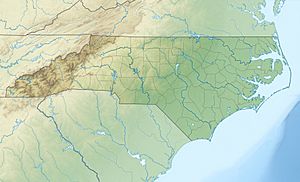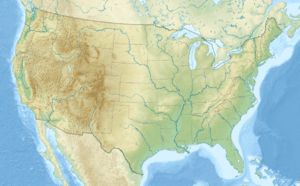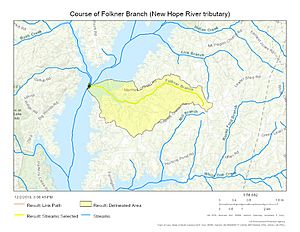Folkner Branch (New Hope River tributary) facts for kids
Quick facts for kids Folkner Branch |
|
|---|---|
|
Location of Folkner Branch mouth
|
|
| Other name(s) | Tributary to New Hope River |
| Country | United States |
| State | North Carolina |
| County | Chatham |
| Physical characteristics | |
| Main source | Rocky Ford and Lick Branch divide about 3 miles west of Green Level, North Carolina 315 ft (96 m) 35°47′02″N 079°57′50″W / 35.78389°N 79.96389°W |
| River mouth | New Hope River B. Everett Jordan Lake 216 ft (66 m) 35°47′33″N 079°00′53″W / 35.79250°N 79.01472°W |
| Length | 3.89 mi (6.26 km) |
| Basin features | |
| Progression | generally west |
| River system | Haw River |
| Basin size | 3.15 square miles (8.2 km2) |
| Tributaries |
|
| Waterbodies | B. Everett Jordan Lake |
| Bridges | Farrington Road |
Folkner Branch is a small stream, about 3.89 mi (6.26 km) long, located in North Carolina. It's known as a "first-order tributary," which means it's one of the smallest streams that flows into a larger river. Folkner Branch eventually joins the New Hope River inside the B. Everett Jordan Lake reservoir.
The Journey of Folkner Branch
Folkner Branch begins its journey from a pond. This pond is located near a dividing line between two other streams, Rocky Ford and Lick Branch. This starting point is about 3 miles west of a town called Green Level, North Carolina.
From its source, Folkner Branch flows mainly towards the west. It continues its path until it reaches the New Hope River. This meeting point is within the B. Everett Jordan Lake reservoir, which is in Chatham County.
The Area Around Folkner Branch
The land area that Folkner Branch drains is called its watershed. This watershed covers about 3.15 square miles (8.2 km2). This means all the rain that falls in this area will eventually flow into Folkner Branch.
The area around Folkner Branch gets a good amount of rain, about 47.0 inches each year. The average water temperature in the stream is around 15.35 degrees Celsius. A large part of this watershed, about 66%, is covered by forests. These forests help keep the water clean and provide homes for wildlife.




